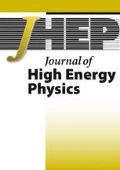Abstract
Motivated by the similarity between cubic string field theory (CSFT) and the Chern-Simons theory in three dimensions, we study the possibility of interpreting \( \mathcal{N} = \left( {{\pi^2}/3} \right)\int {{{\left( {U{\mathcal{Q}_B}{U^{{ - 1}}}} \right)}^3}} \) as a kind of winding number in CSFT taking quantized values. In particular, we focus on the expression of \( \mathcal{N} \) as the integration of a BRST-exact quantity, \( \mathcal{N} = \int {{\mathcal{Q}_B}\mathcal{A}} \) which vanishes identically in naive treatments. For realizing non-trivial \( \mathcal{N} \), we need a regularization for divergences from the zero eigenvalue of the operator K in the KB c algebra. This regularization must at the same time violate the BRST-exactness of the integrand of \( \mathcal{N} \). By adopting the regularization of shifting K by a positive infinitesimal, we obtain the desired value \( \mathcal{N}[{({{\text{U}}_{\text{tv}}})^{{\pm {1}}}}] = \mp {1} \) for U tv corresponding to the tachyon vacuum. However, we find that \( \mathcal{N}[{({{\text{U}}_{\text{tv}}})^{{\pm {2}}}}] \) differs from ∓2, the value expected from the additive law of \( \mathcal{N} \). This result may be understood from the fact that \( \Psi = U{\mathcal{Q}_B}{U^{{ - 1}}} \) with U = (U tv)±2 does not satisfy the CSFT EOM in the strong sense and hence is not truly a pure-gauge in our regularization.
Similar content being viewed by others
References
E. Witten, Noncommutative geometry and string field theory, Nucl. Phys. B 268 (1986) 253 [INSPIRE].
T. Takahashi and S. Tanimoto, Marginal and scalar solutions in cubic open string field theory, JHEP 03 (2002) 033 [hep-th/0202133] [INSPIRE].
M. Schnabl, Analytic solution for tachyon condensation in open string field theory, Adv. Theor. Math. Phys. 10 (2006) 433 [hep-th/0511286] [INSPIRE].
Y. Okawa, Comments on Schnabl’s analytic solution for tachyon condensation in Witten’s open string field theory, JHEP 04 (2006) 055 [hep-th/0603159] [INSPIRE].
T. Erler and M. Schnabl, A simple analytic solution for tachyon condensation, JHEP 10 (2009) 066 [arXiv:0906.0979] [INSPIRE].
M. Murata and M. Schnabl, On multibrane solutions in open string field theory, Prog. Theor. Phys. Suppl. 188 (2011) 50 [arXiv:1103.1382] [INSPIRE].
T. Erler and C. Maccaferri, Comments on Lumps from RG flows, JHEP 11 (2011) 092 [arXiv:1105.6057] [INSPIRE].
M. Murata and M. Schnabl, On multiple D-brane solutions in open string field theory, talk given at String Field Theory 2011, Prague Czech Republic, 20-24 September 2011.
Author information
Authors and Affiliations
Corresponding author
Additional information
ArXiv ePrint: 1111.2389
Rights and permissions
About this article
Cite this article
Hata, H., Kojita, T. Winding number in string field theory. J. High Energ. Phys. 2012, 88 (2012). https://doi.org/10.1007/JHEP01(2012)088
Received:
Accepted:
Published:
DOI: https://doi.org/10.1007/JHEP01(2012)088


